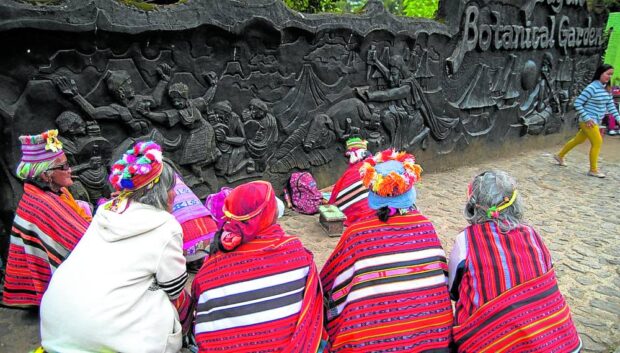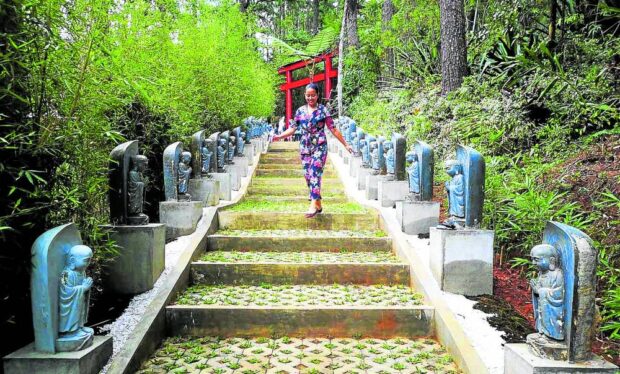Old Cordillerans in Baguio asked to stop photobombing tourists

PARK ATTRACTION | Elderly Cordillera women in native garments, shown in this 2014 photo, have been offering themselves as photo subjects of tourists in exchange for tips at the Baguio Botanical Garden since the late 1970s and 1980s. But park officials are now proposing other tasks for them following the tourist spot’s rehabilitation. (Photo by RICHARD BALONGLONG)
BAGUIO CITY, Benguet, Philippines — Elderly Cordillera women, who charge fees from tourists for joining their “selfies” at the entrance of the Baguio Botanical Garden, are being asked to leave the popular destination, the City Environment and Parks Management Office (Cepmo) told the city council this week.
These old women have been offering themselves as photo subjects to park visitors since the 1970s in exchange for tips. But their presence there appears to have annoyed some tourists.
According to Councilor Lilia Fariñas, chair of the Committee on Tourism, Special Events and Parks, the city government received complaints that the old women were joining family selfies without invitation and were demanding payment.
“We were told some charge fees as high as P300 to P500,” she informed the council on Monday.
Officially, the Botanical Garden’s elderly “photobombers” have not been allowed to transact business at the park and have been asked to leave several times by park employees and members of the city’s Public Order and Safety Division because they do not have special permits, said lawyer Rhenan Diwas, who heads Cepmo.
He said the group disappeared during the 2020 Luzon lockdown prompted by the COVID-19 pandemic and the subsequent community quarantines when parks were closed, but the women returned in 2021 after the Botanical Garden was reopened to the public following 10 months of rehabilitation and modernization undertaken by the city government.

MEMORIES OF WAR | The Japanese section of the Baguio Botanical Garden, as seen in this 2022 photo, features tunnels used during World War II. The park remains one of the top tourist destinations in the summer capital. (Photo by EV ESPIRITU / Inquirer Northern Luzon)
New tasks
“We are tracking down their families instead so their children can convince [the old women] to stop returning to the Botanical Garden,” Diwas told the council, adding that their health and their security are often at risk each time they huddle outside the park.
Diwas said a government committee formed to oversee and regulate commercial enterprises in Baguio parks could propose new tasks or new livelihood opportunities for these seniors instead.
They, however, could be registered as buskers and perform other duties at the Botanical Garden once they are oriented on tourism protocols, said Atanacio Addog, Cordillera director of the National Commission on Indigenous Peoples (NCIP), on Tuesday.
These old women and their predecessors have become “landmarks” of the Botanical Garden for the past decades, and “simply removing them without providing them alternative tasks may draw backlash,” Addog said.
It was after World War II when the Botanical Garden started out as a zoo and the site of an “authentic Igorot Village” for tourists before it was developed into a botanical park years later.
The park’s Cordillera huts still exist, so the women could be employed there as “living models” of their indigenous culture, Addog said.
“These old women have been there since I was a child. It’s been their livelihood, so removing them means killing their source of income. They have become features of the park. Removing them will also remove what makes the park special,” he said.
Addog said the old women could help assemble a “living cultural museum” at the Botanical Garden and showcase their stories about their Cordillera clans. “They would submit to the regulations of the park managers and sign up as buskers, so their fees can be fixed and regulated,” he said.
Many sections of the Botanical Garden have since been adopted and managed by Baguio’s sister cities.
Tunnels used during the war are now part of a tour within a Japanese zone, while special flower groves and kiosks were put up to showcase cities in China, Thailand, Canada, and South Korea.